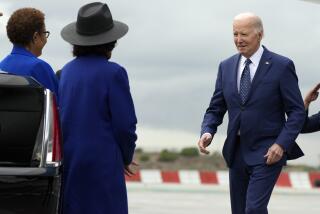Safety Official Says Nassco Crane Wasn’t Meant to Carry People
- Share via
A crane involved in a shipyard accident last year that killed six men and injured six others was not designed to transport people, according to a federal safety official and an attorney representing five of the victims.
In addition, attorney Preston Easley said in a recent interview, his investigation found that the electric crane at National Steel & Shipbuilding Co. lacked a critical anti-freefall mechanism--a backup safety system to brake a falling load.
The problems with the crane’s “operating deficiencies” do not end there, Easley said. A mechanical brake, which can be used manually to prevent a load from falling while the crane boom swings out with the load, is well out of reach of the operator, Easley said.
Nassco officials, meanwhile, say the instructions for the crane contain nothing that prevent the transport of personnel.
The accident prompted a “wall-to-wall” safety inspection of the shipyard earlier this year by the federal Occupational Safety and Health Administration. Two weeks ago, OSHA officials said their probe revealed 451 safety violations by Nassco, and the agency proposed $72,000 in fines.
19 Violations
A separate six-month OSHA investigation of the accident resulted in $62,800 in proposed fines for the company, which was cited for 19 violations relating only to the crane. A report on the accident was released by OSHA in January.
The fatal accident occurred minutes after midnight July 10 when a 4-by-6-foot basket carrying 12 men and their tools fell 30 feet to a deck on the Navy supply ship Sacramento, which was being overhauled. The steel basket was attached to the crane’s boom, which was being swung over the ship to the pier--where it was to be set down--when the basket suddenly began falling.
Easley, a personal injury attorney who specializes in maritime accidents, is representing four workers who survived the accident--the worst ever at Nassco--and the family of one man who died.
On Nov. 22, Easley and a crane engineer he hired inspected the crane after obtaining clearance from an administrative law judge. A federal magistrate later halted discovery in the case while attorneys for the defendants responded to lawsuits filed by Easley, but not before Easley obtained inspection reports, maintenance records, blueprints and operator manuals for the crane.
The attorney said he is researching the history of the crane--identified as Crane No. 7 by Nassco--starting with its manufacture in 1965 by Clyde Iron Works, now known as AMCA International. The defendants in the suits filed in federal court include AMCA International, Nassco and the International Cargo Gear Bureau, the company that inspected the crane four months before the accident and declared it safe.
Easley said documents reviewed by his experts show that the 23-year-old crane was designed to transport only material, not people.
John Hermanson, director of the local federal OSHA office, concurred that the AMCA crane was not manufactured to carry people and should not have been used for that purpose.
OSHA prohibits the use of cranes to transport personnel except in emergencies, but the federal safety agency did not find any mechanical problems with the crane or the steel basket. OSHA also did not pinpoint the direct cause of the accident.
$10,000 Fine
OSHA fined Nassco $10,000--the maximum possible--for using the crane and basket to transport shipyard workers on July 10 and again in October. Its report said the accident could have been prevented if Nassco had used gangways to transport the workers between the Sacramento and the pier.
In his lawsuits, Easley alleges that both Nassco and the crane’s manufacturer are guilty of negligence.
“We know that that’s not a personnel crane,” he said. “There are certain emergency situations in which a material-handling crane can be used to transport personnel, but only if certain procedural steps are taken.”
Nassco has acknowledged that the crane was used routinely on the night of the accident and on other occasions to transport personnel. It also said its use was not triggered by an emergency when the tragedy occurred.
Interview Canceled
Easley said it was AMCA International’s responsibility to warn Nassco not to transport people with the crane.
Regina Petty, attorney for AMCA International, initially agreed to be interviewed about Easley’s allegations, but canceled at the request of company officials.
Fred Hallett, Nassco spokesman and vice president, said the use of crane-lifted personnel baskets was a “routine procedure” at Nassco and other U.S. shipyards. In a telephone interview, he also said the operator’s manual “did not warn” against using the crane to transport personnel.
“In Nassco’s opinion, the manual does not prohibit the transport of personnel,” he said.
OSHA’s Hermanson said Nassco should have used guidelines established by the private American National Standard Institute for transporting personnel by crane. The use of the guidelines, which were drawn up in 1982, is mandated under OSHA’s general duty clause, he said.
Guidelines for Transport
“That crane was not equipped to meet the requirements that are outlined in those standards,” Hermanson said.
The institute’s requirements for the safe use of personnel baskets include:
Safety belts should be attached to the basket for the workers.
A maximum of six workers can be placed in a basket.
A test lift must be done before moving workers.
The crane and all its critical parts must be checked before moving workers.
Access doors on personnel baskets must open inward. The door on the Nassco basket opened outward.
“We’re talking about equipment that was, or was not, on the crane itself, equipment necessary to transport people,” Hermanson said. “It’s a combination of the way the crane was equipped, I assume from the factory, and procedures and policies not developed by Nassco.”
One feature missing from Crane No. 7 is an anti-freefall device to brake a falling load, Hermanson said. The absence of such a device made the crane unacceptable to carry people, he said.
Cable Began Free Fall
But Hermanson said that due to the language of the OSHA regulations, the agency was allowed to cite Nassco only for using the crane to transport people illegally, not for failing to install an anti-freefall device.
According to witnesses and survivors, on the night of the accident the steel cable carrying the basket began to “free fall” toward the deck of the ship. Hermanson said institute standards “and common sense” require that cranes transporting personnel have the automatic freefall device as well as a manual brake.
Hallett confirmed that Crane No. 7 does not have the freefall device, and said the crane was involved in another freefall accident in 1986 that left one man injured. Despite the two accidents, he said that Nassco’s position is that anti-freefall devices are not required, even by institute standards, on personnel cranes.
“We believe that there are no standards that require personnel cranes to be fitted with anti-freefall devices for the shipbuilding industry,” Hallett said. “ . . . We’ve never been cited for not having anti-freefall devices on our cranes.”
Only in Emergencies
To ensure against future accidents, OSHA officials warned Nassco that it can use personnel baskets only in emergencies. The company was put on notice in a letter signed by Hermanson that accompanied the citations instructing Nassco to comply with institute standards in such emergencies.
Nassco has contested 18 of the 19 citations issued as a result of the accident, Hallett said, and has taken the position that there are no OSHA standards that prohibit the “routine” use of shipyard cranes to transport personnel.
“Some of the rules quoted did not apply to us,” he said. “ . . . And some of the rules as stated in the citations did not appear to be correct, in our opinion.”
Hallett also said OSHA has not outlined “its definition of what is an emergency.”
Since the accident, Nassco has established a written policy to govern the use of cranes and personnel baskets, he said. The use of a personnel basket must be cleared by Nassco’s president or senior vice president, “but we don’t have a prohibition against it,” he added.
Cranes that have been used to transport workers in the past, including No. 7, can still be used to move personnel baskets as long as clearance is given by the appropriate company official, Hallett said.
According to Easley, the July accident could have been prevented if Hugh Humphrey, the crane operator, had had access to a mechanical brake called a “dog.” The OSHA investigation cleared Humphrey of any responsibility in the accident.
Charles Remoll, the inspector who certified the crane in March, 1987, said operators are trained to routinely apply the manual brake when they stop a load in midair before turning the crane boom. Remoll, who taught engineering at the U.S. Naval Academy in Annapolis, Md., was interviewed by The Times about a week after the accident.
Crane No. 7 has two lines, and the personnel basket was suspended from one of those when it spilled the workers to a deck of the Navy ship, said Hermanson.
“The line that was being used at the time of the accident winds around the middle drum.The drum has notches around the outer edge of it. A dog is similar to a metal hook that catches in the notches,” said Easley. “And that dog can be set in one of the notches to keep the drum from turning, which keeps the line from playing out.”
Hallett confirmed that the manual brake was kept several feet from the operator on Crane No. 7. He also said the brake is applied “when you do maintenance on the crane or when you’re holding a static load.”
OSHA investigators and Easley said they were aware of reports that the crane suffered a loss of air pressure moments before the accident. Easley, who subpoenaed several Nassco records before the federal magistrate ordered a temporary halt to such gathering, said Humphrey told shipyard officials about the loss of air pressure in a debriefing.
More to Read
Sign up for Essential California
The most important California stories and recommendations in your inbox every morning.
You may occasionally receive promotional content from the Los Angeles Times.










